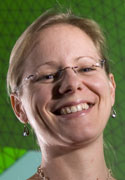Like many who experience living abroad, Beckman Institute researcher Amy Wagoner Johnson says that a year-long stay in France as a teenager changed her life. It wasn’t the rich French culture or history that had a profound effect so much as it was two realizations gained from the experience: one, that she could overcome obstacles, and two, that she had developed an interest in science.
“It was a huge influence in my life,” Wagoner Johnson said of spending her junior year in a French high school.
“My parents say that the person I was before France and after France are like two different people,” she added with a laugh.
Wagoner Johnson’s father was on sabbatical in France from his position as a materials science professor at Ohio State. It was a year in which she became, thanks to her French physics teacher, truly interested in science and engineering, as well as confident in her abilities.
“I got good grades before France but it wasn’t a huge challenge and I wasn’t trying to challenge myself,” Wagoner Johnson said. “I’m not an engineer who, when they were a little kid, tinkers with everything like my dad did. It wasn’t until I was almost an adult that I decided that engineering was very interesting. I think going through this time in France showed me the value of being challenged and just learning that if I wanted to do something I could do it.”
That perspective served Wagoner Johnson well in her academic and professional careers. She earned a Ph.D. from Brown University in engineering with a major in materials science and a minor in solid mechanics, later coming to Illinois for positions as an Assistant Professor in Mechanical Science and Engineering and as a member of Beckman’s Bioimaging Science and Technology group. The lessons she learned in France also meant that if Wagoner Johnson found research interests outside her Ph.D. topic, she was going to explore them.
That is exactly what happened when she became interested in biomaterials following a talk in Boston from a physician who discussed clinical uses for artificial bone. When Wagoner Johnson came to Illinois in 2001 with her husband and fellow Engineering and Beckman colleague Harley Johnson, she was already thinking about a new direction for her research.
“I knew when I finished my Ph.D. that I wanted to change fields and go more into biomaterials,” she said. “This was applying engineering to problems in biology, which did appeal to me. I think the idea that you can relate to it on a more personal level was a factor for me.”
– Amy Wagoner Johnson
Wagoner Johnson’s current research does focus on biomaterials, specifically synthetic bone substitute materials and systems that could be used to replace bone grafts, where bone is harvested from the patient or obtained from donors.
“The biggest part of my research program is studying how we can take a synthetic material and replace natural bone, specifically in large and complex defects,” she said. “In injury cases or in cases of cancer or degeneration of tissue because of things like gingivitis, patients can be missing a very large piece of bone.
“We want to be able to customize these implants so that we can optimize the mechanical properties and optimize the bone in-growth and healing process. To do that, I take it all the way from design and fabrication of an implant to in vivo studies.”
Wagoner Johnson employs hydroxyapatite – a ceramic material commonly used in clinical settings for implant coatings and other applications – as a scaffold that is then modified at the macro- and micro-structural scales for customization. Her lab also studies and characterizes the biological response to the implant, using micro-computed tomography and the Visualization Laboratory at Beckman.
“We use micro-CT data to characterize bone in-growth into our scaffolds more quantitatively than people have done previously,” she said. “We hope that it will help us better understand how and why the bone grows into the scaffold so they can eventually be used in a clinical setting.”
Wagoner Johnson also contributed to the Mandible Project at Beckman which successfully demonstrated that an artificial bone implant could be used in place of bone harvesting. She said that experience helped teach her the importance of having biomedical engineering research that is connected to a clinical setting.
“I think sometimes as engineers we might not realize that,” Wagoner Johnson said. “But it’s important to talk to the clinicians because they know the other issues that come into play, the practicality of using it in the surgical suite, handling it, and how it would be attached. I would be very excited to see these scaffolds being used in a clinic someday.”
Thanks to her own experiences, Wagoner said she encourages students to take on challenges.
“When I advise undergraduates, I always advise that they should go study abroad,” she said. “It was a year that was very important in terms of milestones in my life. It was very influential in terms of what I did. It was a really hard year and very, very challenging but it taught me that if I wanted to do something I could do it.”
